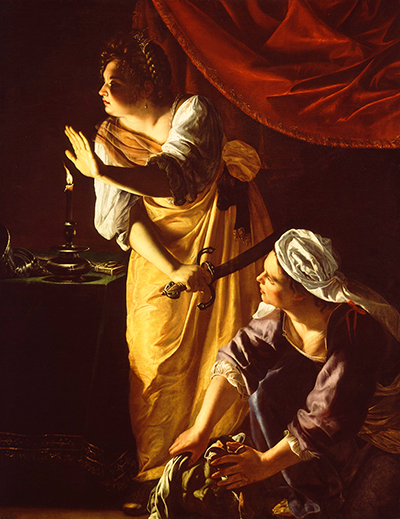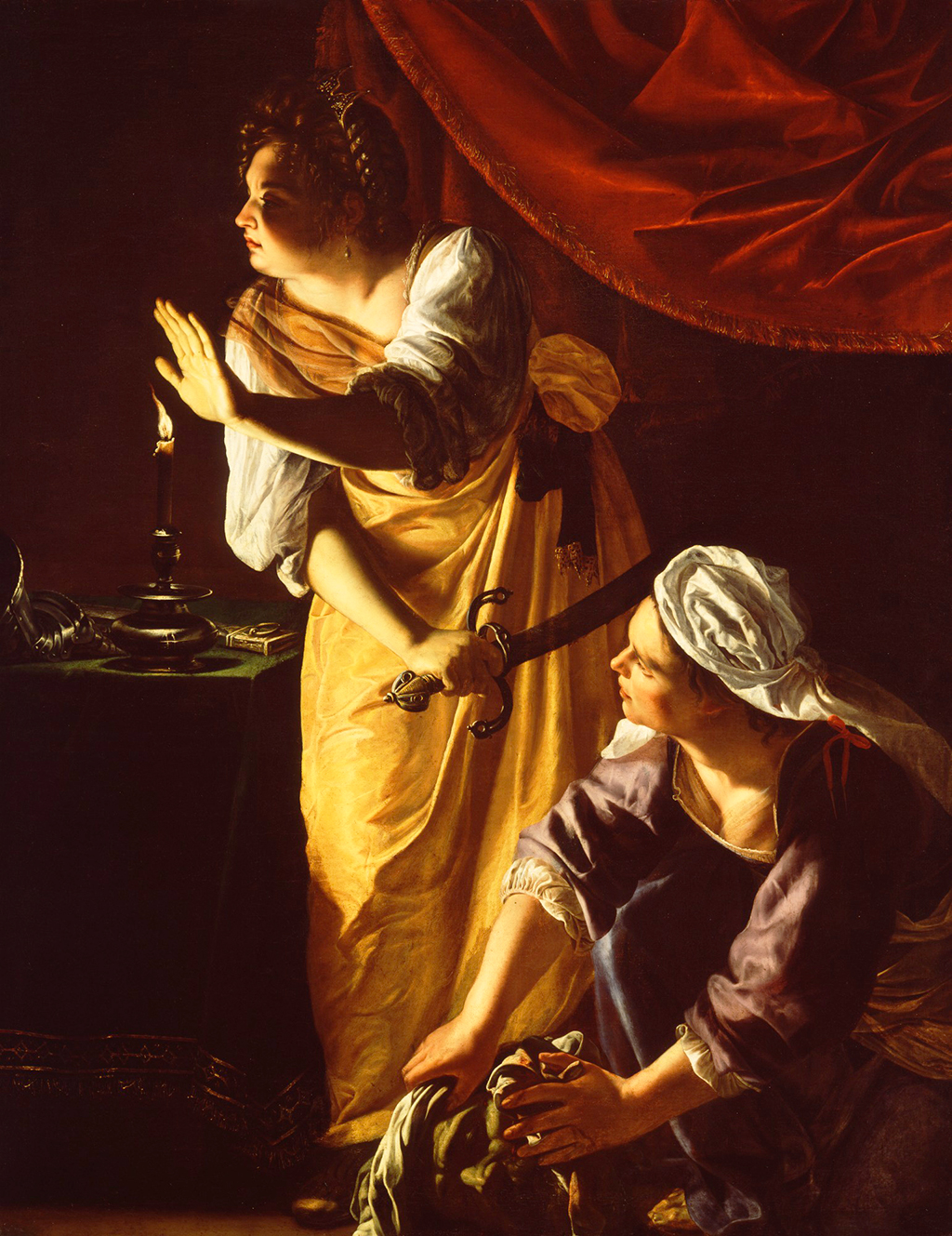The theme of Judith and Holofernes feature in four different paintings by Artemisia Gentileschi, with this composition capturing the moment just after she has beheaded her victim. Her maidservant wraps his head in a bag or cloth whilst she keeps watch.
This painting was completed in circa 1623–1625. The lighting is typically Caravaggio-esque, with extraordinary contrasts between the light and dark elements of the scene. It leaves a dramatic finish which provides a strong focus to the key elements of the painting, and leaves the rest in near darkness. It is the candle to the left of the painting that provides this lighting, meaning the opposing sides of each figure are dimmed substantially. Judith still holds the knife in her hand that she used to behead her foe, but it distracted now as she looks out to make sure no-one is following in afterwards. Her servant wraps up the head as they attempt to deal with the aftermath of this extraordinary event. The original tale actually places the servant outside of the room in which this incident occurs, but Gentileschi consistently chose to include her within each painting that she produced on this theme, underlining her love for the way in which women can work together to overcome the challenges in front of them.
The scene itself captures the tale of Judith beheading the Assyrian general, Holofernes during a visit to his camp. They are under estimated because of their gender and also in that they number just two, against an entire enemy army. They now therefore need to leave the camp in the dark of night in order to avoid being discovered once their brutal murder has been completed. In the original tale, the maidservant would actually be outside, ensuring that Judith is not interrupted in her plan but Gentileschi would bring her into this series of paintings and give her very much a hands-on tole in proceedings. In other pieces she directly held down the male figure which perhaps made the events somewhat more believable in explaining just how Judith managed to overpower her physically far stronger opponent. There is a technical issue within this painting which some art historians have pointed out, where Judith's hand in relation to the lit candle does not look quite right, in terms of the direction of the resultant lighting, but overall this piece is highly regarded within her overall oeuvre.
The battling nature of Judith serves as an inspiration to women and perhaps the artist saw herself within this figure. She went through serious moments of trauma and also worked against the gender imbalance of the art world but fought with a tenacity which also provides us with inspiration at what can be achieved even against the toughest of challenges. In one example from her career, Judith is depicted by the artist with a bracelet which holds the image of Artemis, who famously defended her own honour with great vigour. There can be no doubt that the artist used her own work as a means of processing some of the issues and emotions that happened as a result of her assault several years earlier, at a time when there were no services available that one could use to aid their recovery. In the present day Artemisia has become something of a female icon because of what she achieved against all the odds and this puts her in a similar bracket to the likes of Frida Kahlo who suffered severe injury and a troubled marriage.
"...Compared to her Uffizi Judith the melodrama is much reduced but the final effect is no less powerful..."
Ann Sutherland Harris
This painting is one of the few by Artemisia Gentileschi that can be found in the United States. Most reside in Europe, particularly Italy, Germany and the UK. Judith and her Maidservant can be found at the Detroit Institute of Arts. This notable gallery ranks amongst the finest in the nation, both for quantity and quality of artworks. Besides this impressive piece from the famous Italian artist, you can also find original artworks from a number of particularly famous American artists, as you might expect. Alongside that are a number of other paintings and sculptures by European artists from the Renaissance and Baroque periods, which themselves have greatily influenced the later artists of the US. In recent years the US galleries and museums have also been making a concerted effort to make their displays more diverse, featuring more women than before and also covering art from other cultures, such as Asia and Africa.
An additional element of interest to this particular painting concerning the rise in exposure of female artists in recent years would be that Judith and her Maidservant was actually featured in a highly prominent exhibition of 1976-1977 which is regarded as the first international exhibition of specifically female artists' work ever to have been staged. It was actually considered one of the biggest highlights of the entire show and underlines how she was already highly regarded many decades ago, well before this campaign started to increase in momentum. Today, such exhbitions would be entirely normal and so this shows the progress made in recent years. It is not only the technical brilliance of Gentileschi that ensures her appearance here, but also the way in which her life was directly damaged by the concentration of power within male hands during this time within European society. Over time it is important that the discussion is more about her being an exceptional Renaissance or Baroque artist, perhaps not even mentioning her gender at all and that would represent a real change in society.
Some of the specific highlights of this establishment include William-Adolphe Bouguereau's The Nut Gatherers, Pieter Bruegel the Elder's The Wedding Dance, Saint Jerome in His Study by Jan van Eyck and Giovanni Bellini's Madonna and Child. There are also notable pieces from Claude Monet, Odilon Redon, Eugène Boudin, Edgar Degas, Gerard ter Borch, Peter Paul Rubens, Albrecht Dürer, Rembrandt van Rijn, Hans Holbein, James Abbott McNeill Whistler, Paul Cézanne, Eugène Delacroix, Auguste Rodin, Jean-Baptiste Carpeaux and François Rude. In truth the list is much longer than this, and pretty much all tastes are covered somewhere in the collection, making it an excellent artistic venue for a good variety of ages and interests. They also offer exhibitions which combine some of their permanent collection with pieces loaned in from elsewhere in order to offer curated themes of work that can keep their display fresh and interesting.





